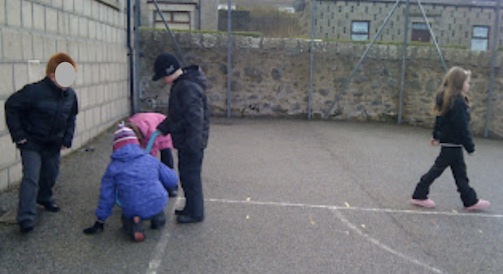In Scotland we have Curriculum for Excellence Through Outdoor Learning. This document is integral to our curriculum. The three overarching statements summarise the expectations:
“Our vision for outdoor learning in Scotland is that:
- All children and young people are participating in a range of progressive and creative outdoor learning experiences which are clearly part of the curriculum
- Schools and centres are providing regular, frequent, enjoyable and challenging opportunities for all children and young people to learn outdoors throughout their school career and beyond
- Teachers and educators embed outdoor learning in the curriculum so that learning in the outdoor environment becomes a reality for all children and young people.”
These are powerful statements. Culturally almost all schools have, by tradition, been conditioned to “think indoors” and this is underpinned by a silent but pervasive myth that “real learning happens indoors”. If I think back to my own time in school, there was not a lot of time spent outside, other than at break and lunchtimes. PE lessons happened outside in the summer months. In one school, we did the occasional country dance festival and had other trips away. But I can only think of one lesson ever taking place outside when I was 9 years old. We looked at a map of the UK painted in the playground.
So, for those in education to embed outdoor learning, is remains a radical shift. During my outdoor training events I’ve been surprised at the willingness of staff to embrace learning outside in spite of all the other changes taking place. There are many issues and concerns. A key one is what and how can one teach a large class outside?
This blog post is about one time when I was faced with this sort of challenge. The weather forecast was poor and I was visiting a school to undertake several outdoor activities. Amongst the topics I had been given were World War II and the Romans. Now although I was a class-committed head teacher for most of my time, I rarely taught history. I did consult a couple of books which gave me un-helpful last-minute advice, such as making turf mazes and hiring a gladiator for a day! Neither option is last-minute.
So I resorted to devising team problem solving challenges. For the WWII session, we had to escape from prison through a field littered with mines. This involved lots of hoops to jump into and plenty of “booms” as where there traps lay were discovered. Perhaps not the most right-on, politically correct activity but it kept the children warm and engaged. It acclimatised them to learning outside. If you want to know more, have a look at Activity 24 on Page 25 of this download. This was what I adapted to this theme.

The next challenge was to look at the new playground markings and devise a game or activity linked to WWII that involved the playground markings. This was a lovely piece of lateral thinking that the children managed rather well.

In the afternoon, the children practised walking together. That may sound dull but it’s surprisingly absorbing! The class had looked at how Romans had to march together and had practised this in previous lessons. The first challenge was to walking across the playground, ensuring that every child crossed the line at exactly the same time with the same foot. After that, the children had to work out how many steps the team could take in 10m. By the time the children had practised, measured, discussed and practiced more than an hour had passed.
Back inside, the follow up possibilities were considerable. There was a lot of discussion around the variation in the number of steps taken in 10m. But once this is agreed, it was easy to look up distances between towns and work out the number of steps soldiers would have walked 1800 years ago.
As well as team challenges, several other activities can be used successfully as last moment lessons that can be linked to any theme. These include setting up trails and treasure hunts that link to a theme and undertaking a drama-based problem solving activity along the lines of Mantle of the Expert. The challenge in winter is to ensure that the activities do involve children moving around so that they keep warm.

Any further suggestions? I’ll be delighted to know what has worked well for you as spontaneous lessons outside.
This blog post was originally published in November 2010.




















Wow Juliet, you are amazing! I would have never thought up those activities as quickly as you did, what a success.
Even though I work with preschoolers who love to be outside, I also believe all ages of children do, IF their teacher can make it fun and enjoy nature.
I wish I could have seen you work with these kids in action!!
Wow! Are those markings on the playground area permanently? I bet teachers would be more willing to be out there if they had those as “resources”. In the United States, no one seems to care much about kids being outside (sadly). I do remember doing the same map activity outside in elementary school (except it was a map of the US.)
Hi Jackie
Yes – the markings are “thermoplast” ones which are extra tough and durable. They are expensive but a good investment if one knows what markings to put down.
Strangely we don’t do four-square over here – other than when North American visitors come to schools and bring the game.
You always have such amazing outdoor play.
Passed along a blog award to you!
Thanks for the continued inspiration.